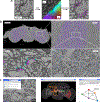Automatic detection of synaptic partners in a whole-brain Drosophila electron microscopy data set
- PMID: 34168373
- PMCID: PMC7611460
- DOI: 10.1038/s41592-021-01183-7
Automatic detection of synaptic partners in a whole-brain Drosophila electron microscopy data set
Abstract
We develop an automatic method for synaptic partner identification in insect brains and use it to predict synaptic partners in a whole-brain electron microscopy dataset of the fruit fly. The predictions can be used to infer a connectivity graph with high accuracy, thus allowing fast identification of neural pathways. To facilitate circuit reconstruction using our results, we develop CIRCUITMAP, a user interface add-on for the circuit annotation tool CATMAID.
Conflict of interest statement
Competing Interests Statement
Stephan Gerhard is the founder and CEO of UniDesign Solutions GmbH, which provides IT services.
Figures




References
-
- Denk Winfried, Briggman Kevin L, and Helmstaedter Moritz. Structural neurobiology: missing link to a mechanistic understanding of neural computation. Nature Reviews Neuroscience, 13(5):351–358, 2012. - PubMed
-
- Li Peter H., Lindsey Larry F., Januszewski Michal, Zheng Zhihao, Bates Alexander Shakeel, Taisz István, Tyka Mike, Nichols Matthew, Li Feng, Perlman Eric, Maitin-Shepard Jeremy, Blakely Tim, Leavitt Laramie, Jefferis Gregory S. X. E., Bock Davi, and Jain Viren. Automated Reconstruction of a Serial-Section EM Drosophila Brain with Flood-Filling Networks and Local Realignment. bioRxiv, April2019. doi: 10.1101/605634. - DOI
-
- Dorkenwald Sven, Schubert Philipp J, Killinger Marius F, Urban Gregor, Mikula Shawn, Svara Fabian, and Kornfeld Joergen. Automated synaptic connectivity inference for volume electron microscopy. Nature methods, 14 (4):435, 2017. - PubMed
-
- Motta Alessandro, Berning Manuel, Boergens Kevin M, Staffler Benedikt, Beining Marcel, Loomba Sahil, Hennig Philipp, Wissler Heiko, and Helmstaedter Moritz. Dense connectomic reconstruction in layer 4 of the somatosensory cortex. Science, 366(6469), 2019. - PubMed
Publication types
MeSH terms
Grants and funding
LinkOut - more resources
Full Text Sources
Molecular Biology Databases

